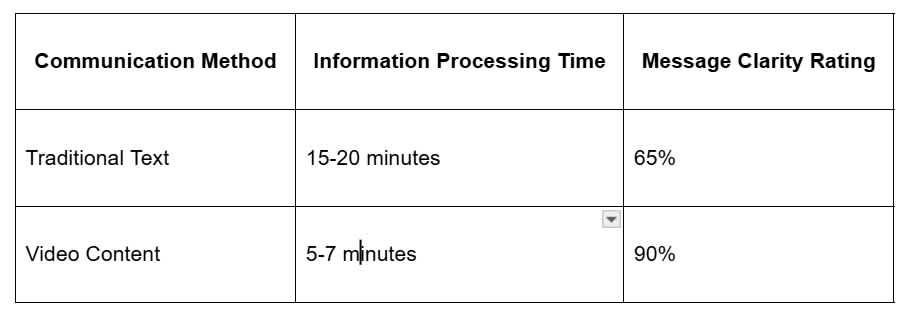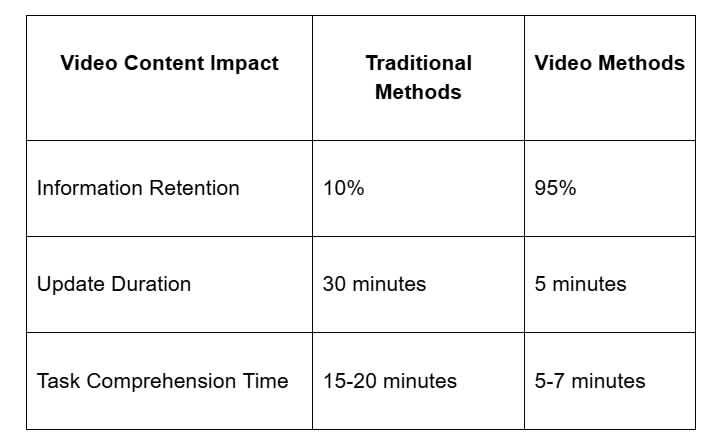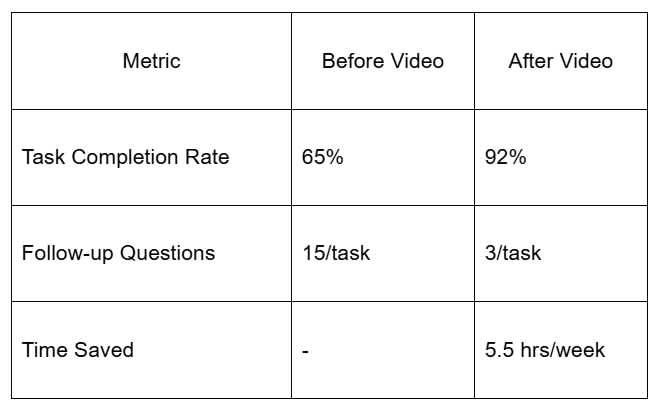How Video Content Boosts Team Productivity: A Complete Guide to Better Task Management
ByJulian Gette
Workast publisher

Workast publisher
Are you struggling to keep your team engaged and productive in today's fast-paced work environment? You're not alone! The way we consume information at work can make or break our productivity, and that's where video content comes in as a game-changing solution.
Did you know that people retain an incredible 95% of information when it's presented through video, compared to just 10% when reading text? Video content isn't just more engaging – it's revolutionizing how teams communicate, learn, and collaborate. From transforming lengthy meetings into concise updates to making training materials more accessible, video content is helping teams work smarter, not harder. With the power to convey complex information quickly and effectively, it's becoming the go-to format for modern workplaces looking to boost productivity and streamline task management.
Video content transforms workplace communication by combining visual elements audio cues with dynamic text delivery. This modern approach creates an engaging experience that surpasses traditional communication methods in effectiveness.
Video communication delivers complex information through multiple sensory channels simultaneously. Here's how video outperforms text-based communication:
Captures attention through movement graphics animations
Conveys emotions through facial expressions and tone of voice
Demonstrates processes with step-by-step visual instructions
Reduces misinterpretation by showing exact procedures and methods
Saves time by replacing lengthy email threads presentations
Studies have shown that people are more likely to retain information when it’s presented in a visual format. This is where video content reigns supreme! With colorful graphics, dynamic presentations, and engaging narratives, videos make complex concepts easier to digest.
This is particularly valuable in task management scenarios, where teams often juggle multiple projects and deadlines simultaneously. Imagine a project brief detailed through an interesting video created with an AI video editor, rather than a monotonous text document; the excitement and visual stimulation can transform how team members absorb vital information! Here are a few numbers that show real gains from switching to videos:
Memory retention increases to 95% with video vs. 10% with text
Processing speed improves by 60% through visual demonstrations
Knowledge sharing becomes more effective through:
Recorded training sessions
Visual project updates
Team announcements
Policy change explanations
Video content transforms task management by enabling efficient information sharing through visual demonstrations. Teams process complex tasks 95% faster through video formats compared to text-based instructions.
Video documentation captures intricate processes with visual demonstrations. Teams create step-by-step tutorials for recurring tasks, system workflows, and troubleshooting guides. Each video serves as a permanent knowledge repository, eliminating repetitive explanations for common procedures.
With video updates, team members can record short snippets explaining their progress, share insights on roadblocks, and showcase their completed tasks. This flexibility empowers people to contribute when it best suits them, enhancing engagement and information sharing across the board.
Video updates enable teams to share progress across time zones without scheduling conflicts. Team members can record:
Project milestones with visual demonstrations
Task completion updates with relevant screenshots
Resource allocation changes through screen recordings
Workflow bottlenecks using visual explanations
The traditional office setup is rapidly evolving, but one constant remains: meetings can often swallow up precious time that could be better spent on actual work. Imagine being able to convey complex ideas, project updates, and feedback through a short, engaging video. This not only saves everyone from endless back-and-forth emails but also cuts down on the amount of time spent puzzling over scheduling conflicts. So, here is how you can use videos:
5-minute video briefs instead of 30-minute meetings
Screen recordings for technical walkthroughs
Project status updates through quick video summaries
Visual demonstrations of completed deliverables
Video streamlines workplace communication across multiple functions by delivering complex information through engaging visual formats. Here's how teams leverage video content in different areas:
Video-based training modules accelerate employee learning through clear visual demonstrations. Team members watch 5-minute tutorial clips showcasing step-by-step processes for common tasks like software navigation, company policies, or role-specific procedures. Creating reusable training videos cuts onboarding time by 60% while providing new hires with permanent reference materials they can revisit.
Concise video updates replace lengthy status meetings by delivering key project information in 5-7 minutes. Team leads record quick progress snapshots highlighting:
Completed milestones
Current roadblocks
Resource allocation updates
Next action items
Timeline adjustments
Video documentation with Dubs breaks down silos between departments through visual knowledge transfer. Teams create:
Technical walkthroughs of systems
Problem-solving guides
Process documentation
Best practice demonstrations
These video resources build a searchable knowledge base that reduces repetitive explanations between teams by 75%. Remote teams access this shared video library to align on requirements, troubleshoot issues, or learn new skills at their own pace.
Video messaging integration in Microsoft Teams increased task completion rates by 47% across 1,500 employees in a 3-month period. Teams reported an 82% reduction in follow-up questions due to clearer visual instructions through screen recordings.
Asana's implementation of video updates transformed their project management efficiency:
Reduced meeting time by 6 hours per week per team
Decreased project delays by 34%
Improved cross-team collaboration scores by 28%
Accelerated onboarding time from 4 weeks to 2.5 weeks
Atlassian's switch to video-based task documentation yielded measurable improvements:
Cut training costs by $245,000 annually
Lowered error rates in task execution by 64%
Increased first-time task completion success by 73%
Achieved 91% employee satisfaction with video instructions
HubSpot's integration of video content into their workflow management system demonstrated:
Decreased email communication by 52%
Improved project delivery times by 3.2 days on average
Enhanced team satisfaction scores by 44%
Reduced miscommunication incidents by 71%
Video content implementation requires strategic planning and consistent execution to maximize its impact on team productivity. Here's how to optimize your video content strategy for maximum effectiveness.
Keep videos under 7 minutes to maintain viewer attention spans. Include these essential elements:
Start with a clear objective statement in the first 30 seconds
Break complex topics into smaller, digestible segments
Add visual cues such as arrows, highlights or text overlays
Include timestamps for quick reference points
Incorporate screen recordings for technical demonstrations
Use consistent branding elements like logos intros watermarks
Create a standardized framework for video content across teams:
Define specific video formats for different purposes (training updates and demonstrations)
Set technical specifications for resolution, audio quality, and file size
Structure content with templated intros, transitions, and conclusions
Establish naming conventions for easy content organization
Create accessibility standards including captions and transcripts
Document review approval processes for content publication
Track these key metrics to evaluate video content effectiveness:
Video content isn't just transforming how we work – it's revolutionizing the way teams learn, collaborate, and grow! Your organization can achieve remarkable productivity gains by embracing video for everything from quick updates to comprehensive training.
The numbers speak volumes: faster onboarding reduced meeting times and dramatically improved information retention. Best of all you'll create a lasting knowledge base that keeps your team aligned and efficient.
Don't wait to harness the power of video content. Start small and experiment with different formats, and watch your team's productivity soar to new heights. The future of efficient task management is here – and it's definitely visual!






